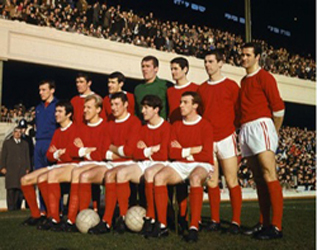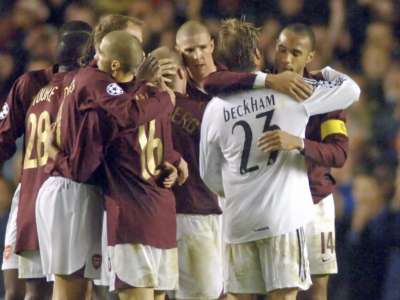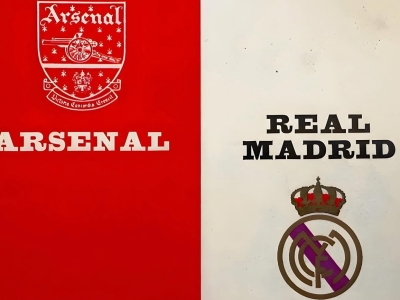There have been many names forwarded to take over from Arsene Wenger when he finally leaves the club, though one name that probably won’t be suggested is Colin Lewin. Few people in their right mind would consider promoting the club Physiotherapist as First Team manager, however in 1966 this is exactly what happened at Highbury. On June 13th 1966, Billy Wright resigned as Arsenal boss after four unsuccessful years in charge at Highbury. Forty six year old Bertie Mee was then appointed acting manager within a week.
It was common knowledge that Bertie was so unsure of his future position that he had asked the board for assurances that he could have his old job as physio back should things not work out. The role was initially accepted on a trial period. Mee was a relative unknown outside of those within the game. He did however hold notoriety with people within the game and within the club. Bertie was known for exercising a strict discipline regime with recovering injured players, as well as providing FA run lectures on injury treatment to other club physios at Lilleshall. Mee was a disciplinarian and one telling observation he made on his taking over at Highbury had been that: ‘the players were a good crowd, but I felt they could be more dedicated to the job and certainly could care more for the Arsenal. The danger was that mediocrity was being perpetrated’.
What Mee had in discipline however, he lacked in coaching expertise. On Billy Wright’s exit, his coach Les Shannon left Highbury to take up a vacant manager’s job at Bury. In his place came former Chelsea coach and Leyton Orient boss Dave Sexton – who Frank McLintock had noted had the gift of: ‘getting through to players without shouting the odds and screaming at them’. While Mee was appointed in the summer of 1966, England were in the process of challenging for – and winning - the World Cup on home soil. Arsenal had just one unused player within the squad, George Eastham. On Billy Wright’s exit however, Eastham decided to move on and joined Tony Waddington’s Stoke City. Meanwhile, Bertie Mee’s first signing had been Tommy Coakley from Motherwell.
One legacy of Billy Wright’s period at the helm however would be reaching back to back FA Youth Cup Finals. In 1965, Arsenal lost 2-3 to Everton over two legs. In 1966 however, Arsenal defeated Sunderland 5-3 on aggregate to win the trophy for the first time. Future first team regulars within the squad were full backs Pat Rice and Sammy Nelson. Another legacy as seen from the pic above, is that since the start of the 1965/66 Arsenal had dropped the white sleeves that were incorporated into their Red kit under Herbert Chapman back in 1933, wearing a simple all red shirt with a white collar and cuffs. Arsenal’s away kit for 1966/67 meanwhile would be an almost Spurs-like all white kit.
Arsenal’s first pre-season friendlies were two games played behind closed doors at their London Colney training ground. The first had been at the end of July against an England XI just a few days before their World Cup Final tie with the West Germans at Wembley, the second was against third tier Watford in early August where Arsenal ran out 2-1 winners. England won the World Cup the following Saturday. On August 5th 1966, the Beatles released their ground breaking ‘Revolver’ album. One day later, Arsenal took a trip to Ibrox to play Rangers for Bertie Mee’s first game in charge in front of a paying audience. Arsenal crashed to a 0-2 defeat in front of a crowd of 40,000. Forty eight hours on, Arsenal headed to Dunfermline to play out a 0-0 draw in front of 8,000 people.
On the last Saturday before the start of the 1966/67 league season, Arsenal headed to Leeds Road to play a friendly with Huddersfield Town of the old Second Division. A goal from Jon Sammels gave Arsenal a 1-0 win. Seven days later came the start of the League campaign with a trip to Roker Park to play Sunderland. Goals for George Armstrong and two for Alan Skirton gave Arsenal a 3-1 victory. Bertie Mee’s first game at Highbury the following Tuesday saw the visit of West Ham, with a side that contained World Cup winning heroes Bobby Moore, Martin Peters and Geoff Hurst. A crowd of 40,614 turned out for the game. Goals for Tommy Baldwin and John Radford gave Arsenal a 2-1 victory with Johnny Byrne on target for the Hammers.
The following Saturday saw the crowd shrink back down to 26,762 for the visit of Aston Villa. The game was captured by the ITN cameras, as another for Tommy Baldwin meant a 1-0 win for Arsenal and three wins on the bounce. Forty eight hours on, Arsenal made the eight mile trip to Upton Park to play West Ham at the Boleyn Ground. Arsenal dropped their first points of the season with Bobby Moore and Peter Brabrook on target for the Hammers and goals for Frank McLintock and Jon Sammels as Arsenal secured a 2-2 draw. Meanwhile, a few hours later over at Candlestick Park in San Francisco, the Beatles played their last ever gig. Arsenal ended August 1966 in second place, only kept off of the top spot by Burnley on goal average. After a good start to the season however, Arsenal began to lose form.
The first game of September 1966 was a visit to White Hart Lane to play fourth place Spurs in front of a crowd of 56,271. Goals for Cliff Jones and two for Jimmy Greaves inflicted a 1-3 defeat, while Jon Sammels was on target for Arsenal. Next up three days on was a visit from the previous year’s defeated FA Cup Finalists Sheffield Wednesday. The Owls were unbeaten with three wins and two draws. A goal for Jon Sammels earned Arsenal a 1-1 draw. The following Saturday, Arsenal headed to Maine Road to face newly promoted Man City, managed by former Arsenal Captain Joe Mercer and his flamboyant assistant Malcolm Allison. Ahead of Arsenal’s visit, the Blues had suffered three straight defeats. Another goal for Jon Sammels cancelled out a Glynn Pardoe strike as the two sides played out a 1-1 draw. Forty eight hours on, forward Alan Skirton had transferred to Blackpool.
The following day, after six seasons of avoiding entry to the Football League Cup, the pull of the Final of the competition being played at Wembley and a guarantee of Fairs Cup qualification meant that the Gunners decided to give the trophy a crack. Arsenal played their first ever fixture in the competition with a visit from third tier Gillingham. Just eighteen months prior, Arsenal were knocked out of the FA Cup to Peterborough United and fears were present that Arsenal might face another shock. Only 13,029 spectators turned out for the tie at Highbury. The Gills went in at half time a goal up, after a twenty five shot from Charlie Crickmore found the net. A goal from Tommy Baldwin spared Arsenal’s blushes, taking the tie to a replay. Making his final competitive appearance for Arsenal at right back that evening was Don Howe.
Back in the league, next up were thirteenth place Blackpool, who were one place above Arsenal in the league on goal average. Making his debut for Arsenal was Colin Addison, who had been signed from Nottingham Forest earlier in the month. Tommy Coakley’s first goal for Arsenal earned the Gunners a 1-1 draw. There then followed a trip to the Medway to face Gillingham in the League Cup replay. The replay attracted a crowd of 20,566 – seven thousand more than turned out at Highbury. The match however was played out in thick fog. Charlie Rackstraw put the Gills ahead past the hour mark, before Tommy Baldwin equalised to take the game to a second replay back at Highbury.
The final league fixture of September 1966 was a visit to Stamford Bridge to face Tommy Docherty’s Chelsea side. Arsenal had only managed one win from their last eleven games against the Blues. In front of a crowd of 48,001, goals for Peter Osgood and two for Bobby Tambling meant a 1-3 defeat for Arsenal, with Colin Addison on target for the Gunners – his first goal for Arsenal. That defeat meant that Arsenal ended September 1966 in tenth place. Four days later back at Highbury, Gillingham visited for the League Cup second replay with a crowd of just 18,409 turning out. Arsenal finally bagged their first win in just over one month with a 5-0 victory secured with goals from Tommy Coakley and two apiece for Frank McLintock and Tommy Baldwin.
October 1966 started with a visit from Leicester City to Highbury. Lining up for the Gunners had been George Graham, who just one week prior had been on the Chelsea side that faced Arsenal at Stamford Bridge. GG headed to Highbury in a swap deal with Tommy Baldwin going the other way, whose two goals against Gillingham in midweek turned out to be his farewell present for the Gunners. GG managed a goal on his debut, along with another from Colin Addison, but couldn’t prevent the Foxes inflicting a 2-4 defeat on the Gunners. Within days, Arsenal however went on to strengthen their side further by signing Bob McNab from Huddersfield Town. Four days later, West Ham visited Highbury for the third round League Cup tie.
The tie had meant a debut for seventeen year old John Woodward and eighteen year old FA Youth Cup winner Micky Boot. Goals for Martin Peters and two for Geoff Hurst saw Arsenal face their first ever elimination from the League Cup with a 1-3 defeat, while David Jenkins would be on target for the Gunners. After failing to win their last six games in the League, Arsenal faced a visit from Newcastle United to Highbury. The game would feature on BBC’s ‘Match of the Day’ – which now for the first time this season was shown in front of a wider national audience on BBC1 on Saturday evenings at 10.30PM (this would however be Arsenal’s only appearance on the show throughout the 1966/67 season).
Two minutes into his League debut, Micky Boot put Arsenal ahead (according to Kenneth Wolstenholme he was threatening to quit the game just a few months prior!). On twenty five minutes Frank McLintock added a second, as Arsenal secured their first win since August with a 2-0 victory. Arsenal secured two points, however no great transformation in the Gunners’ form occurred. Next up was a trip to Elland Road to face Leeds United. There would be a debut for Bob McNab and another goal for Micky Boot, but Arsenal crashed to a 1-3 defeat. After Boot’s run of two goals in four games, he disappeared from the first team squad and was sold to South African side Port Elizabeth City the following March, having never played top level football again.
Another seven days on back at Highbury, two goals for George Armstrong was not enough to prevent a 2-3 home defeat to West Brom. The month ended with a trip to Old Trafford to face sixth place Man United. A goal for David Sadler inflicted a 0-1 loss on the Gunners, which meant the Gunners finished October 1966 in fifteenth place. Arsenal’s first fixture of November 1966 saw a visit from Leeds United to Highbury on the day of Guy Fawkes Night. Don Revie’s side were languishing in twelfth place and had won just four of their first thirteen games. Arsenal lacked sparkle and crashed to a 0-1 defeat. There followed a 0-0 draw one week later away at eleventh place Everton.
Three days on from Goodison, Arsenal were to play Cardiff City in a friendly fixture to raise money for the Aberfan Disaster Fund. To those unaware of the circumstances of the Aberfan Disaster, around three weeks prior to the Benefit match with Cardiff, there had been several days of heavy rain which led to the collapse of a colliery spoil tip within the small Welsh village of Aberfan that had accumulated over half a century. As a result, 1.4 million cubic feet of debris covered a section of the village in minutes, which had led to the deaths of 144 people. 116 of those who perished had been school children, as the debris had engulfed the Pantglas Junior School just hours before the school was to break up for half term holidays.
In the benefit match itself, goals for Frank McLintock, Colin Addison and two for John Radford meant a 4-2 win for Arsenal. Also as a result of this match, Arsenal later signed Cardiff forward George Johnston. The following weekend, a goal from Frank McLintock gave Arsenal a 1-0 win at home to relegation threatened Fulham – only their third victory in just under three months. Highlights of the game would feature on ATV London’s ‘Star Soccer’, though no ATV footage for the 1966/67 season seems to be available on the internet’s video sharing websites (and knowing archiving policies of British TV stations during the 1960s, may even possibly have been wiped altogether). In Arsenal’s final fixture of November 1966 however, the Gunners were unable to put together a winning run.
1965 FA Youth Cup finalist Gordon Neilsen bagged his first goal for Arsenal, however it was not enough to prevent Arsenal crashing to a 1-2 defeat to Nottingham Forest at the City Ground. Arsenal ended November in fifteenth place. December 1966 started with two draws – a goalless encounter with third place Burnley at Highbury (highlights of which were covered by ATV’s ‘Star Soccer’) had been followed by a 1-1 draw with ninth place Sheffield United at Bramall Lane. Sheffield United’s colours of red and white meant for the first time since the 1950 FA Cup Final, Arsenal were required to wear a third kit. Arsenal turned out in blue for the first time in eight seasons. At Bramall Lane, George Graham bagged his first goal since scoring on his debut. At the half way mark of 1966/67, Arsenal languished in sixteenth place in the old First Division.
There then however came a run of seven wins out of nine for Bertie Mee’s side. Nine days ahead of Christmas 1966 saw the visit of Sunderland to Highbury, with a crowd of just 20,482 turning out for the game. Goals for Frank McLintock and Jon Sammels gave Arsenal a 2-0 victory. On Boxing Day, newly promoted Southampton faced their first ever trip to Highbury. The only other previous meeting between Arsenal and Southampton at this point had been an FA Cup Semi Final at Stamford Bridge in 1927, where an Arsenal victory saw the Gunners progress to their first ever FA Cup Final. Two goals apiece for George Armstrong and John Radford saw Arsenal run out 4-1 winners, while Ron Davies would be on target for the Saints.
Twenty four hours on saw Arsenal’s first visit to the Dell in their return fixture with Southampton. The Gunners crashed to a 1-2 defeat, with future Brighton boss Jimmy Melia and Terry Paine on target for Southampton, while Colin Addison scored for Arsenal. This match would also be the tenth and final appearance in an Arsenal shirt for Jimmy McGill. Arsenal’s final game during the calendar year of 1966 came with a trip to play Aston Villa at Villa Park on New Year’s Eve. A goal for Frank McLintock earned Arsenal a 1-0 victory. A goal for Frank McLintock gave Arsenal a 1-0 win (this would be the last fixture between Arsenal and the Villa for the next eight years, after the Midlanders suffered relegation at the end of 1966/67 and a spiral down the divisions).








